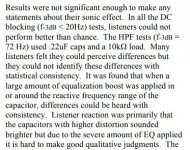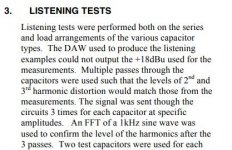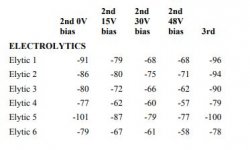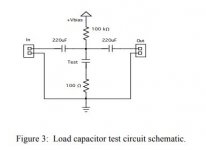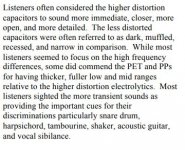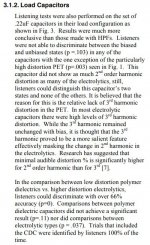limited for free student version. I dont use student version.
-RM
Neither do I.
I understand now. I find recordings made in large venues better be played with the original flat low end RIAA and no rumble filter. If the speakers are low end capable, the ambient low freq content of the recording makes a difference. I would prefer to lower the volume setting to cater for cone excursion with such recordings rather than cut the low end.Current RIAA has a 20Hz hi-pass. Most people have a low cut somewhere to save their speakers.
Dimitri was kind enough to lend me an extra copy of his latest project, an LP low frequency noise simulator.
Dimitri is one very low profile, highly capable designer
That, I suppose, depends on philosophy, as I really don't care what the recording/mastering process is, except whether or not I enjoy the sound
Daniel by “The elephant in the room” I meant that it is a case of general interest (in contrast to the limited number of vinyl users), as microphones are used in every recording, regardless of format release.
George
you could always listen to the old Tomita Pictures at an Exhibition, I doubt any mics were used in that release. 🙂
Cheers
Alan
(who prefers music recorded with mics)
Cheers
Alan
(who prefers music recorded with mics)
I don't have clips, but you may read the reference from my note Condenser microphone uses dc-coupled mpedance converter
dc coupled microphone preamp was described here R.Chalupa A Novel Topology for a DC-Coupled Phantom-Powered Microphone Preamplifier
dc coupled microphone preamp was described here R.Chalupa A Novel Topology for a DC-Coupled Phantom-Powered Microphone Preamplifier
Last edited:
limited for free student version. I dont use student version.
Models are easiy added to library. But like in any of them, the form to enter data on model isnt often very complete anyway. If you can even get good data.
Like no model of polar cap only film type.
-RM
partial model of electrolytic. add DA, esl, Rp etc.
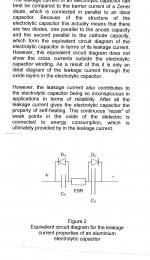
THx-RNMarsh
Last edited:
I don't have clips, but you may read the reference from my note Condenser microphone uses dc-coupled mpedance converter
dc coupled microphone preamp was described here R.Chalupa A Novel Topology for a DC-Coupled Phantom-Powered Microphone Preamplifier

AES needed for the other
from Robert-Eric Gaskell "Capacitor “Sound” in Microphone"
Chalupa amp discussion can be found here New: A Direct-Coupled Input-Capacitorless Active Mic Preamp - Pro Audio Design Forum
Results were not significant enough to make any statements about their sonic effect. In all the dc blocking (f-3db < 20hz) tests, listeners could not perform better than chance. ... Many listeners felt they could perceive differences but they could not identify these differences with statistical consistency. It was found that when a large amount of equalization boost was applied in or around the reactive frequency range of the capacitor, differences could be heard with consistency. Listener reaction was primarily that the capacitors with higher distortion sounded brighter but due to the severe amount of eq applied it is hard to make good qualitative judgments.
Chalupa amp discussion can be found here New: A Direct-Coupled Input-Capacitorless Active Mic Preamp - Pro Audio Design Forum
Last edited:
OK Jan, here is both for 1Vp output, quite realistic value. You can see that in case of "appropriate JFET hand matching selection" the distortion is vanishing low and only H3 for these smaller signals.
With 10V OP the distortion is OK but not fantastic. With 1V OP it is certainly better however afew things should be considered:
- The overall gain is fairly low, so pretty easy to get good linearity from degeneration
- You are measuring at 1kHz. Try 10kHz and it will almost certainly rise significantly due to non linear capacitances of OP cascode Mosfets.
T
Sometimes, reading this forum, we come across a brilliant and useful idea, and, as is the case here, described with elegance.I don't have clips, but you may read the reference from my note [URL="https://www.edn.com/Pdf/ViewPdf?[/URL]
You put me in a good mood for the full day or more ;-) Thanks, Dimitri.
Last edited:
I don't have clips, but you may read the reference from my note Condenser microphone uses dc-coupled mpedance converter
Thanks Dimitri,
Clicking on the reference
Just gives an error page.Reference
1. Gaskell, Robert-Eric, “Capacitor ‘Sound’ in Microphone Preamplifier DC Blocking and HPF Applications: Comparing Measurements to Listening Tests,” Audio Engineering Society, Presentation 130, Paper 8350, May 2011, pg 1.
The referenced paper is here: AES E-Library >> Capacitor "Sound" in Microphone Preamplifier DC Blocking and HPF Applications: Comparing Measurements to Listening Tests
Capacitor "Sound" in Microphone Preamplifier DC Blocking and HPF Applications: Comparing Measurements to Listening Tests
The sonic effect of capacitors in various aspects of audio electronics design has long been discussed and speculated upon. Recent publications have tested many of these theories through rigorous distortion measurements of a variety of capacitor types under several test conditions.
One particularly interesting result is a measurable increase in 2nd harmonic distortion for electrolytic and PET type capacitors when a DC bias is applied.
This article repeats these measurements for a set of capacitors commonly used in +48V phantom power blocking applications and high-pass filters in microphone pre-amplifier designs.
These physical measurements are then compared to the result of double blind listening tests in order to examine the audibility of these capacitor distortions as well as explore their sonic effect on various program materials.
Author: Gaskell, Robert-Eric
Affiliation: McGill University, Montreal, Quebec, Canada
AES Convention: 130 (May 2011) Paper Number: 8350
Publication Date: May 13, 2011 Import into BibTeX
Subject: Posters: Audio Equipment
Permalink: AES E-Library >> Capacitor "Sound" in Microphone Preamplifier DC Blocking and HPF Applications: Comparing Measurements to Listening Tests
Can someone take a look at the entire paper and report back, thanks.
Cheers,
Jeff
Last edited:
The paper does not, at least for me, offer new insights. Capacitor distortion tests were modeled after Bateman and also after Self. Results largely the same in tendency although exact numbers differ - the capacitors used were of course also different.
Listening tests gave results indistinguishable from chance, except with extreme equalization, see attachments.
Note that because of equipment limitations they ran each test sample through the capacitor test circuit three times to get the same THD profile stuff as in the measurements. So actually they could have just done the listening test with the THD profiles, because that is what they really compared...
What you also see, which is common in these types of tests, that people *think* they can distinguish, but do not better than chance in their voting.
Jan
Listening tests gave results indistinguishable from chance, except with extreme equalization, see attachments.
Note that because of equipment limitations they ran each test sample through the capacitor test circuit three times to get the same THD profile stuff as in the measurements. So actually they could have just done the listening test with the THD profiles, because that is what they really compared...
What you also see, which is common in these types of tests, that people *think* they can distinguish, but do not better than chance in their voting.
Jan
Attachments
Last edited:
It appears they did everything they could to make things worse. In reality there would be 20V or so DC bias and 100mV signal would be a fairly high SPL.
Would you measure one of JC's or Nelson's open loop amps at just below clipping and compare it to a high feedback design that has no distortion until it clips?
Would you measure one of JC's or Nelson's open loop amps at just below clipping and compare it to a high feedback design that has no distortion until it clips?
Next are the results for 'capacitor load' tests, see attached test circuit.
Here results were more consistent, with - again as often is the case - listeners preferring the more distorted version of the sound. Although 66% confidence is not something to write home about.
Note also that the CDC which was detected 100% of the time is included as a very high distortion reference ceramic cap ;-)
Jan
Here results were more consistent, with - again as often is the case - listeners preferring the more distorted version of the sound. Although 66% confidence is not something to write home about.
Note also that the CDC which was detected 100% of the time is included as a very high distortion reference ceramic cap ;-)
Jan
Attachments
Last edited:
What a strange way to consider things, for a designer.What you also see, which is common in these types of tests, that people *think* they can distinguish, but do not better than chance in their voting.
A lot of "people" "think" they can "distinguish" some capacitances sonic effects. You are free to think differently. (I.E. *you* can't hear them).
But, why do-you want to convince them they are wrong ? Because you consider yourself as the guardian of the absolute truth? Because you consider them as victims of illusions and not you ?
For some reasons, you prefer a cap here or there ? Nobody prevents you from using them. The success of your designs will be the sole judge of the merits of your choices.
I, personally, consider as more profitable to find ways to address the question, when it is possible.
A way to satisfy *them* and get rid of some other problems like the prices and sizes of good capacitors in the audio path.
As always, you start from measurement results to decide what can be heard or not. This is not the correct method in Audio, on my point of view. The right method is to listen and then measure to find what can justify what you heard , if possible, the fastest way to improve the result.
Because we don't measure everything, and don't know the thresholds of audibility of each and everybody on this planet.
As in all human creative activities, excellence goes through humility.
And science is a tool, a work in progress. And not a religion.
Last edited:
Tryphon, before you write an entire rant about being the arbiter of truth, did you read the line from the first attachment in #1652?! "Did not reach significance"
I mean, yes, Jan has his moments, but maybe read before opening your mouth and sticking your judgmental foot in it? Maybe give pause and humility before you position yourself as morally superior and somehow above everyone else in this thread?
I mean, yes, Jan has his moments, but maybe read before opening your mouth and sticking your judgmental foot in it? Maybe give pause and humility before you position yourself as morally superior and somehow above everyone else in this thread?
Last edited:
What a strange way to consider things, for a designer.
You misunderstood. I was not considering anything, just noting an observation. That makes the rest of your post irrelevant, which I therefor not quoted.
And no need to thank me for downloading a $ 33 paper, reading it, making shots of relevant parts and posting those. Because I know there are others that actually look at the contents rather than get all excited by the name of the mailman.
Jan
Last edited:
Well, as usual, everyone is a little bit correct and none totally.
Take DA for example. How much DA from a capacitor is developed into voltage depends on the external circuit Z's and the Rda value. That ratio.
Greater Vda (recovery voltage) will be developed across a high Z than low Z. Relatively. The Rda is much higher in film caps than electrolytics. So, more voltage will be developed across a given Z with polar/electrolytics (lower ratio).
Hearing 2H is always interesting because we have so much 2H in a typical dynamic driver that I would think any small amount would be hard to detect by speaker masking alone. So only really low distortion speakers should be used to determine if a parts' 2H can/could be audible to some people on better (lower thd) speakers.
Without Standards of Z and a standard speaker for reference to, there are so many variables known and unknown that this subject will continue long after i am gone, it seems.
The practical solution, otherwise, is to use only the most accurate parts with the smallest parasitics or eliminate the part when possible; At least from a perfectionists point of view (audiophile?).
I coined the phrase 'no capacitor is the best capacitor' to side step which cap dielectric is better and under what conditions and DBLT et al on coupling caps.
THx-RNMarsh
Take DA for example. How much DA from a capacitor is developed into voltage depends on the external circuit Z's and the Rda value. That ratio.
Greater Vda (recovery voltage) will be developed across a high Z than low Z. Relatively. The Rda is much higher in film caps than electrolytics. So, more voltage will be developed across a given Z with polar/electrolytics (lower ratio).
Hearing 2H is always interesting because we have so much 2H in a typical dynamic driver that I would think any small amount would be hard to detect by speaker masking alone. So only really low distortion speakers should be used to determine if a parts' 2H can/could be audible to some people on better (lower thd) speakers.
Without Standards of Z and a standard speaker for reference to, there are so many variables known and unknown that this subject will continue long after i am gone, it seems.
The practical solution, otherwise, is to use only the most accurate parts with the smallest parasitics or eliminate the part when possible; At least from a perfectionists point of view (audiophile?).
I coined the phrase 'no capacitor is the best capacitor' to side step which cap dielectric is better and under what conditions and DBLT et al on coupling caps.
THx-RNMarsh
Last edited:
Richard, for all your worry about DA, can you show an ecample of swapping otherwise well matched caps in bypass application and seeing material differences? I'm taking greater than 100 dB, because physical size and layout could easily supersede DA in this application. Single test worth thousand opinions, but that may be a couple orders of magnitude off.
Otherwise it's a lot of words to hand wring, especially in light of so many tests showing extremely low distortion amplifiers with ac coupling.
Otherwise it's a lot of words to hand wring, especially in light of so many tests showing extremely low distortion amplifiers with ac coupling.
Sorry, the part of your post I quoted was not from you ?You misunderstood. I was not considering anything, just noting an observation.
I have to apologize, I don't realized that the paper you cited was so exceptional and that it was worth such a sum of money. The only thing that would have interested me were the references of the measured capacitors (if they are available on the shelf) , all along with the results and conditions of measurements. As presented, It was looking more as an attempt to give weight to an opinion.
I believe everything had been told about this capacitance subject since decades. If I remember well, the Jung and Marsh paper was published in 1980.
And is available for free.
And, quoting the same mr. Marsh: "The practical solution, otherwise, is to use only the most accurate parts with the smallest parasitics or eliminate the part when possible;".
... means the paper that could be very useful: A set of measurements of most of the best available parts in the actual market.
Last edited:
- Status
- Not open for further replies.
- Home
- Member Areas
- The Lounge
- John Curl's Blowtorch preamplifier part III
